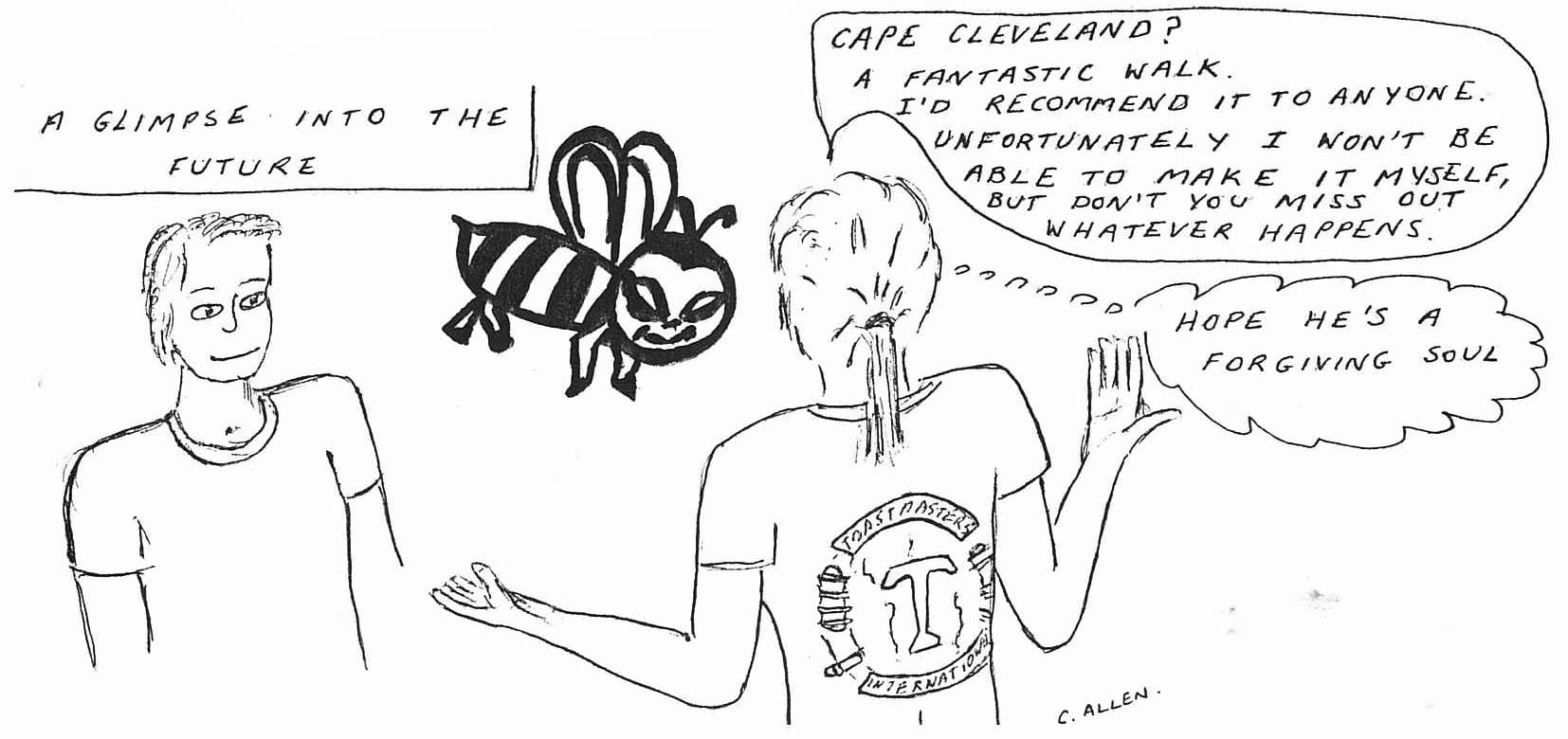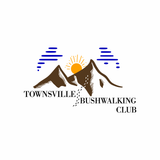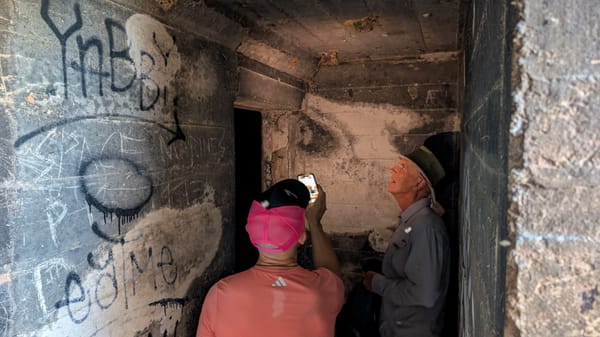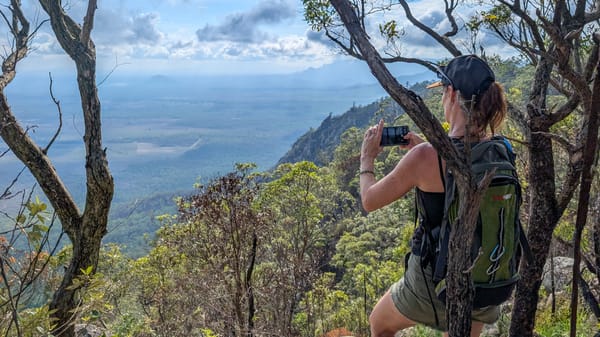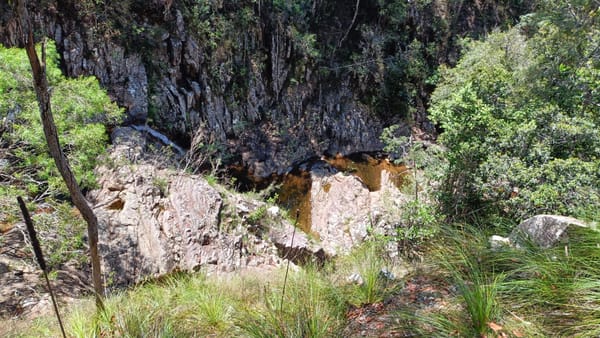Escape Magazine - October 1986
The October 1986 Townsville Bushwalkers ESCAPE Magazine features Bishop’s Peak hikes with sweeping views, Cape Cleveland adventures, Blue Gum Creek challenges, and stories of goannas. Packed with trip reports, camping tips, and club updates for bushwalking in North Queensland.
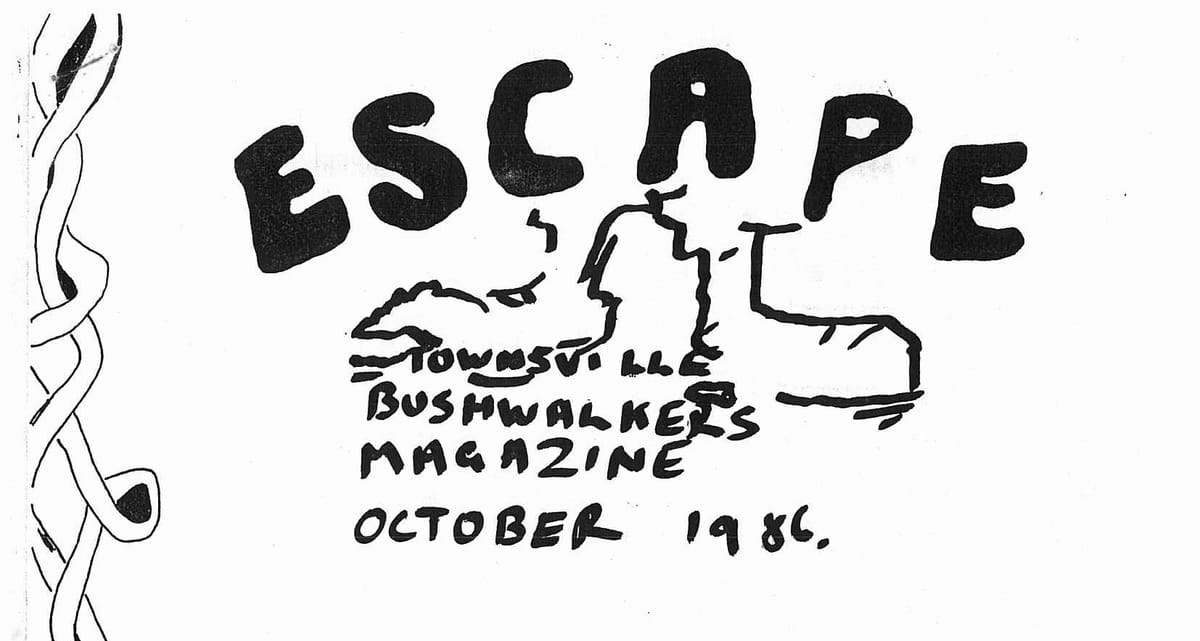
ESCAPE
TOWNSVILLE BUSHWALKERS MAGAZINE
OCTOBER 1986.
EDITORIAL
The end of the year is drawing near. We've had a few memorable walks since our last newsletter and some of these are related in articles in this newsletter. My thanks go to all those of you who contributed articles. The response has been tremendous. If we have been unable to print your contributions in this newsletter, don't despair. We have a bonus Christmas issue coming out in December. I would like to suggest to contributors that if possible, articles be submitted typed and be accompanied by a map or some form of illustration.
For those of you who didn't make it out of bed because of rain on September 28, missed an enjoyable walk on Running River/Puzzle Creek. The weather was lovely and cool...and it didn't rain! So if it looks like rain, don't give up. There are always alternative walks to do. I look forward to the rest of the year's programme.
Editorial Panel: Glynis Lee & Bea Duffield
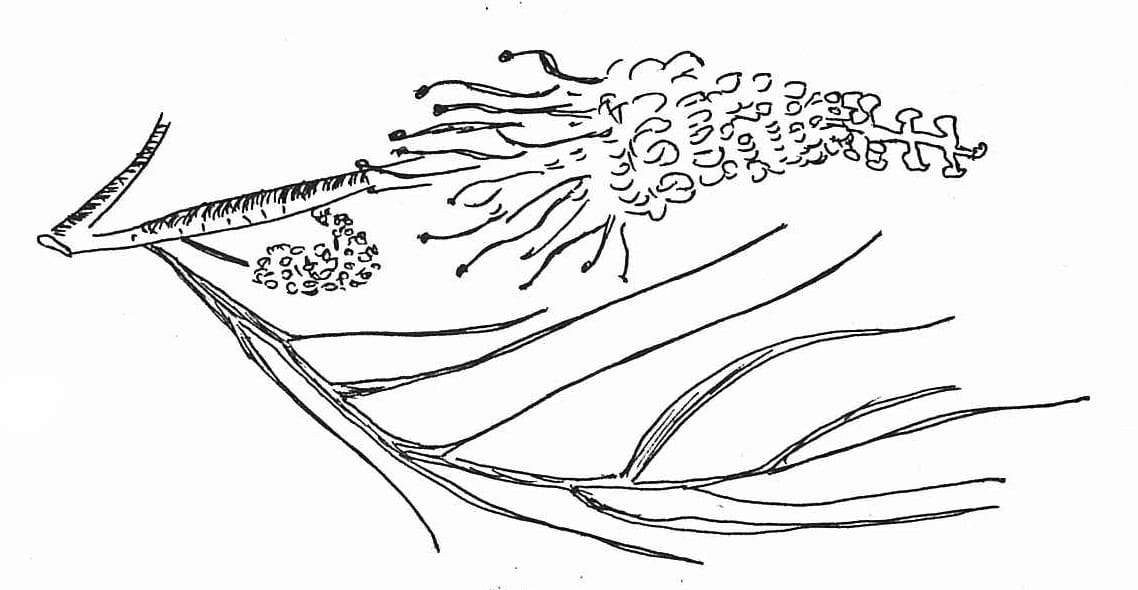
THE BISHOP'S PEAK WALK
Of all the walks I've been on, Bishop's Peak was the most enjoyable. Where else around North Queensland can you climb a 3000ft peak for a 360 degree view which includes the Hinchinbrook ranges almost cloud-free?
About 20 people arrived at 6.30am at the Aitkenvale post office. Marion hadn't arrived, so Gavin, Tony, Mary Jane and I stayed behind to wait for her. We must have made quite an impression on passers-by as we were throwing a frisbee in the parking lot of Nathan Plaza at 7.00 Sunday morning.
The morning was cool, but clear and promising good weather for the ascent. I can't remember what time we arrived at the car park at the base of the mountain, but it must have been fairly late as the rest of the group had already left for the mountain. I found Bishop's Peak a fairly easy walk. It seemed to be the way you wish bushwalks would be but never are. Everyone made quick progress up the mountain except for Tony who was carrying a large backpack in training for his trip to Nepal in October. We eventually caught up with the others who had been waiting for us for quite a while.
The going was fairly straight-forward from this point on, and it wasn't long before we could see the summit ridge. What made this mountain different from others was the fact that bushfires had cleared the last 1000ft of most of its vegetation. This makes Bishop's Peak look out of place in the Tropics.
The group I was with was falling further and further behind the others and it became apparent that if I was going to make the summit, I would have to make a bid for it on my own. My only misgiving about the summit plateau was that there weren't any trees and I had no way of judging how far I had to go before I reached the top of the mountain. In fact, it wasn't long before I did reach the summit to find a panoramic view. (Everyone did make it to the summit, even though some were later than others. Ed.)
What looked particularly interesting from the point of view of future bushwalks was a tableland stretching between Bishop's Peak and some smaller but no less interesting peaks. I definitely would recommend this walk.
Bill Kinsey
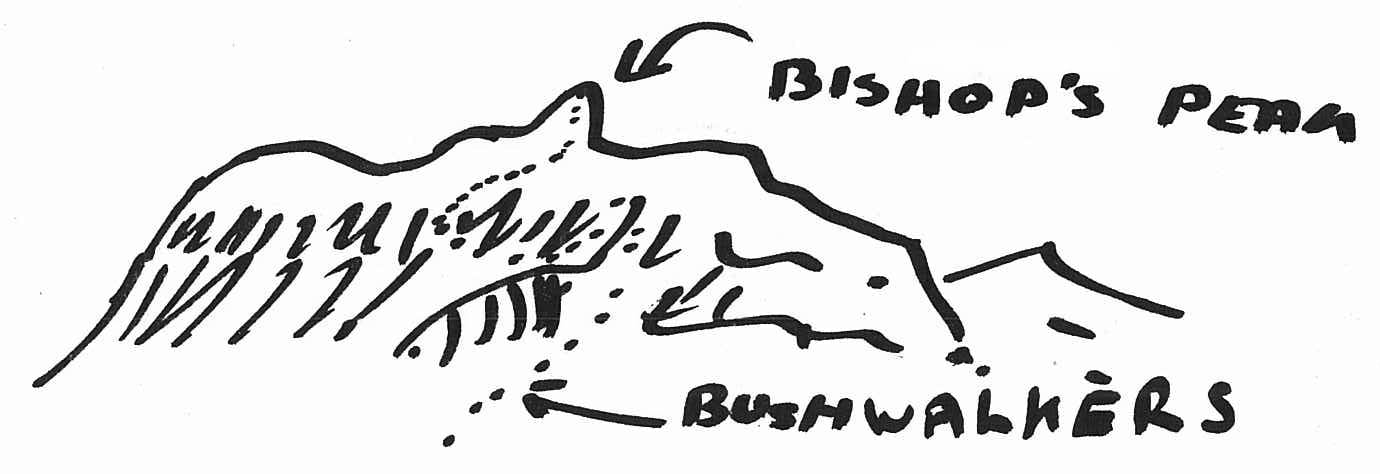
OLD MAN GOANNA.
Coming from Tasmania, I have seen the usual assortment of tiger snakes, skinks, copperhead and whip snakes, and blue tongue lizards; but the sighting of these reptiles could not compare to the excitement I felt when I saw my first sand goanna on a trip to Cape York in 1975.
We reached the Archer River, forty miles north of Coen and decided to camp for a few days. John went for a walk along the river bank, and I started to wash some to the red dirt I was caked in, from my clothes and body.
Suddenly John returned very excited, and said he had seen a sand goanna. He rushed to get his camera and telephoto lens and tripod. I grabbed the binoculars and followed him. We approached cautiously from the opposite side of the river bank, and sat quietly under a tree.
The goanna was digging a hole in the sand. He dug with his strong looking front claws, about five digs with one foot, and the same with the other. Occassionally he seemed to sense us, stop digging, and stood on his hind legs and gazed around. We remained very still, and must have posed no threat, because he soon returned to his digging. On one occassion, he ran and hid under a nearby boulder, stayed for about a minute, then returned to the hole.
We could not see clearly what he was doing, but every so often, he would lift his head out of the hole and gulp two or three times, and apeared to be swallowing something. I have read that sand goannas dig holes to lay their eggs, and also as burrows, but I think he may have been eating some form of insect, or eggs of another animal.
He repeated the gulping procedure four times. After twenty minutes, he left the hole and walked slowly away over the sand dunes. We followed his tracks, and soon came upon him sitting quietly on a log enjoying the sun. We took some photos and left him undisturbed. On investigating the hole, we found it was made into a sand bank, approximately 2½ feet deep.
No attempt had been made to cover it.

The sand goanna belongs to the family Varanidae. A common species of Australian goanna (Varanus gouldii), the sand goanna, is found throughout the continent of Australia, but not in Tasmania, from the wet coastal areas to the inland deserts. They may reach a height of up to five feet, but the average is three to four feet. Colour varies with the habitat, from almost black in South West Australia, to a brightly coloured desert form. Our Archer River goanna was about three feet long, and blended beautifully with his sandy surroundings.
The limbs are strong and muscular, and the goanna possesses a strong tail, which cannot grow back when broken. He has long, sharp, curved claws. The head is pointed, with a dark streak, edged above and below with white from the eye to the neck.
Goannas feed on insects, lizards, birds, mammals and snakes. A plant eaten by the goanna is said to neutralize snake venom. This legend was immortalized in Banjo Paterson's poem "Johnson's Antidote".
Other legends surrounding the sand goanna are also very interesting. Many strongly believe that goanna bites never completely heal, and continue to break open every one to seven years. This legend has been disproved, and the slow healing attributed to secondary infection, from decayed food and bacteria entering the wound from the goanna's mouth. Goanna oil or fat is supposed to have amazing powers of penetration, and said to be able to pass through glass.
Unlike his relation, the tree climbing goanna (Varanus varius), the sand goanna rarely climbs trees, unless as a means of escape when threatened. He can move extremely fast when he has to. He is mild tempered, but can stage a terrifying bluff if necessary. Increasing in height by standing on hind legs, he swells his throat pouch, and hisses at his opponent, shooting his forked tongue in and out.
Probably due to the isolated habitat, our goanna had not learned to fear man, and did not seem to mind us at all. With his tough leathery skin with scales lying up against one another, instead of overlapping like those of some other lizards and snakes, he appeared ageless.

A WALK UP BLUE GUM CREEK
14 walkers had put their names down for this circuit walk along the ridges south of Paluma and back up Blue Gum Creek. Only nine of them showed up. The threatening rain no doubt accounted for the large drop out rate. We began from Paluma about 9 am, in the clouds. It was an ominous beginning to a walk which would fail to realise its full potential.
For the first two hours, we walked along a gradually deteriorating logging road. The occasional concrete pipe sticking out of the ground stood as a re-minder that this road had seen better days. By the time we reached the branch we were meant to take down to Blue Gum Creek, it was raining. Far worse still the trail we were planning to follow proved to be too overgrown to carry on.
Five of us continued along another branch in a south-westerly direction. The remaining four walkers turned back, their morale no doubt boosted by the thought of a hot cup of tea at the Ivy Cottage. The logging road ended about 1.5 kms further, in a lightly forested area. We carried on along the main ridge line and after a slow descent reached a major creek about 2 p.m. After a quick lunch, we pressed on. It was still raining and the rocks in the creek were too slippery to allow safe progress.
Instead, we decided to traverse the slope on the western side of the valley. The gradient was steep, the grass rather thick and slippery. Progress was slow. It came to a sudden halt when I almost stepped on a large black snake hidden in the grass. It was a magnificent specimen, even bigger than the one we had seen earlier that day. I wonder which one, the snake or I, got scared most. I cleared the spot in record time. The snake, uncertain as to what was going on, started thrashing wildly about, repeatedly stricking the grass in all directions. Eventually, it got sick of it and, realising there was no one left to vent its anger on, slithered away in the grass. Is not it a hard life being a snake in this part of the country, with all those mad bushwalkers about?
By 4 pm we were back in the creek as the valley began widening. 300 metres further downstream, we reached a cattle trail. We followed it, on and off, for the next 40 minutes, occasionally crossing the creek in the process. At 5.15 pm we reached Smith Creek and soon came across a perfect camping spot. It had all the desired features: near a flowing stream, plenty of level & clear ground, and heaps of dry wood. There was enough room to set up 100 tents. We spread out, some more successfully than others. Things were made even more pleasant by the fact that it had stopped raining as soon as we came out into the open. Later on, as the clouds cleared up, we caught glimpses of the moon and stars. We had a really pleasant evening by the camp fire. We even spared some thoughts for those unfortunate walkers who turned back earlier and had to face another night in the city. Eventually, we retired to our tents quite late, fairly optimistic about the next stage of the walk.
It began raining again by 5 a.m. the next morning. The rain was intermittent but we had to pack up under a light drizzle. We were on our way by 8.25 am and headed west along cattle trails and 4x4 tracks. On the way we had a quick look at a somewhat rundown hut, complete with beds and mattresses. Its purpose seems to be the accommodation of stockmen when they muster cattle into the nearby yards. It would make a handy shelter on a day of heavy rain. Since all the trails gradually turned south, we left them and struck across the bush until we reached Blue Gum Creek by 10 am. By then the rain had stopped.
We spent the following five hours moving northwards up the creek. Initially our progress was relatively fast and easy as we followed well defined cattle trails on the eastern side of the valley. A pleasant feature of those trails was the view we got up and downstream. We had lunch on time, for a change, and then went on crossing the creek a number of times as the valley began narrowing. There was little evidence that cattle had been that far upstream and we had to make our own way.
By 2 pm, we reached the spot where a previous party walking down the creek had turned back in January. It began raining once again. The next one and a half hours were spent between that spot and the waterfall. It was slow, slippery and frustrating work, with the ever present danger of falling and getting hurt. We frequently had to get off the creek and walk along the hillsides to avoid dangerous stretches of wet rock. The rain began clearing as we reached the waterfall. We gave the traditional swim in the pool a miss. The only swimmer to be seen was a large turtle which after resting a while on a rock disappeared back into the green depths of the pool.
After a short break, we went up the slope, through the old mine area and up the trail back to Paluma. The township was once again in the clouds. There was little life to be seen. The only person we met was the owner of the Ivy Cottage who was still carrying the "OPEN" sign he had just removed from the entrance. I guess when he saw those 5 wet and dirty walkers coming up the main street he decided, quite wisely, it was time to close. We reached our cars by 5.30 pm. I was great to be back. What a misfortune the week-end was wet. The walk has got a lot of potential though. No doubt someone will try doing it again; may I suggest during a dry week-end.
JPS
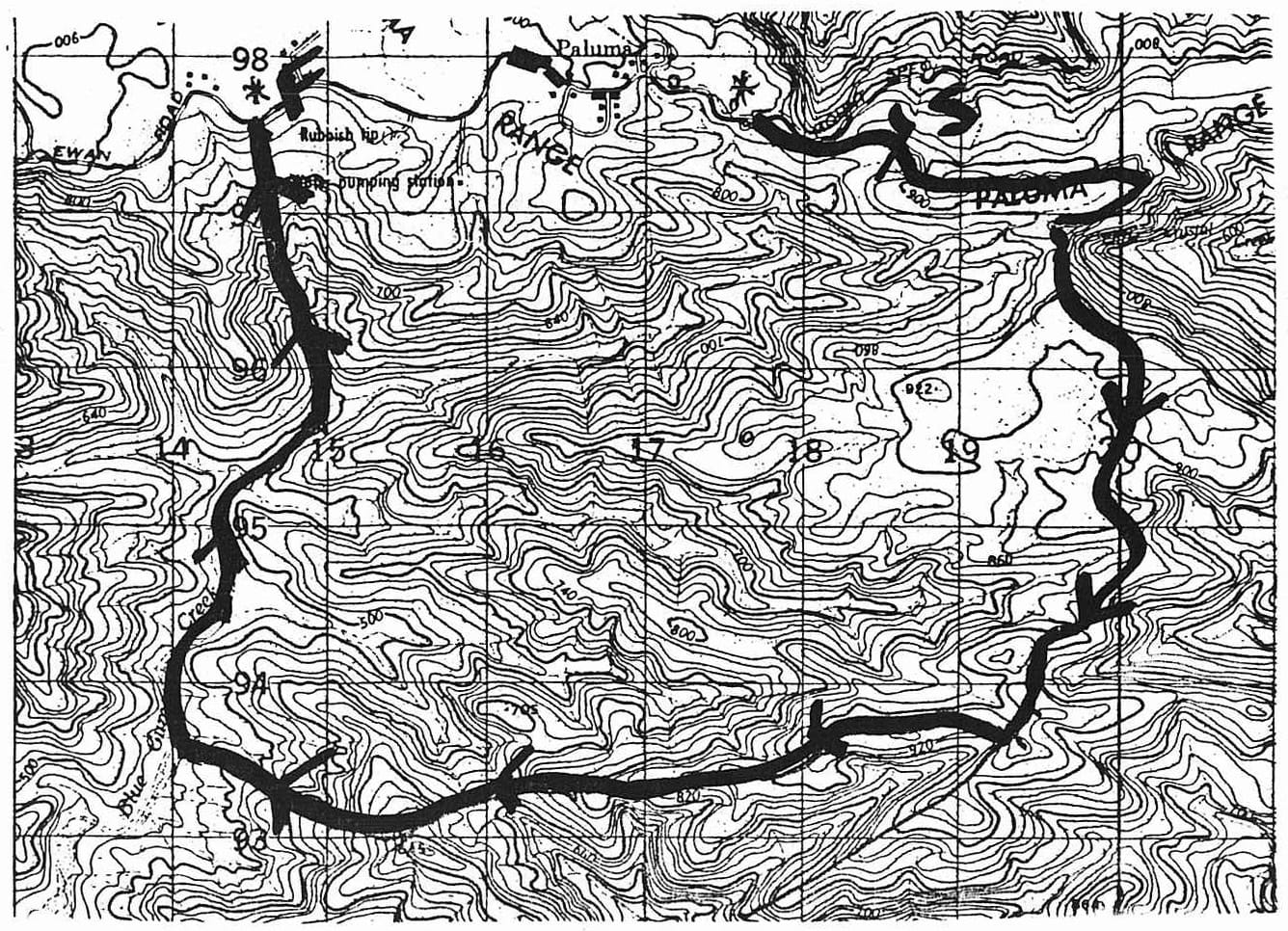
ONE OF MY GREATEST MISTAKES!
On the weekend of July 19th-20th 1986, I had two choices. One was to go to the Sheraton Breakwater Casino for breakfast and have a flutter on the roulette wheel or, two, to go on a two day bush walk to Cape Cleveland.
After much debate, (ie. Gavin telling me it was the worst walk he has ever been on due to the mozzies and marsh flies), I stocked up on RID and decided to go on the walk. Yes, that is correct. I chose Cape Cleveland over a leisurely breakfast at the Casino. No-one could accurse me of being a GIRL! Besides, Dave White (an ex-aquaintence of mine), assured us there was an easy route along a ridge. "Just up a hill behind AIMS and along the ridge to the lighthouse," he said. "The hill is the worst bit as it is a bit steep." (Little did we know that the hill was to be the best bit of the walk).
Anyway 13 of us (I should have realised then what the weekend would hold), set out on Saturday morning from AIMS. We parked in the car park then walked back along the road to climb the hill (500m). You can imagine what the view would be like from the top as it swept Cleveland. We also tried to imagine what the view was like-we could not see anything at all as we were in cloud! A few people (ie. Anne and Steve) who lugged their cameras along took a few uninspiring shoots (of cloud!).
I will not go into the hour by hour details of the walk otherwise I will get too depressed. Yes, there was mozzies and march flies and rock and spear grass and the worst scunge in which I have ever been. Steve kept believing that we must be on the wrong ridge to the one that Dave mentioned. To me they all looked pretty horrible!
We persisted along the ridge Rambo fashion (ie. mindlessly) until after lunch. Then we had enough. We decided to get off the ?#*@!! ridge via a creek bed. Now I understand the meaning of "out of the frying pan into the fire". The creek was steep and full of boulders that were very rough on the hands and the bottom. It took us hours to finally get to the beach.
We had shelved our original idea of getting to the light house at Cape Cleveland. The beach had a fishing hut with fresh water tanks so we replenished our supplies. Because of the threat of mozzies, everyone except the "real" bushwalkers (ie. Steve and myself) had tents. Steve and I slept under a fly but I was so tired I would not have felt the mozzies even if they carried me away.
Next day, we set out for Paradise Bay and HOME (emotions- ch Joy, happiness, relief). More spear grass, more scrunge, more rocks and as an added bonus, lantana At least the swimming at Paradise Bay healed our cuts and bruises.
We made it back to AIMS at about 4.00pm and I will just finish off with a few quotable quotes from those who were on the trip to show I am not biased:-
STEVE- "This is the worst walk I have ever been on"
BARBARA- "Well... it could have been nicer"
ALLAN- "It is not much fun"
JOHN- "At least it is not Mt. Elliot (author-Mt. Elliot must have been the pits!)"
BEA- "I am glad Marianne is not here"
ALLAN- "The only good thing was there was no stinging trees or wait-a-while"
MARY-JANE- Silence
BILL- "Well, I thought it was a fun adventure"
ANNE- "Shut up Bill"
Lessons learnt from this trip
- Carry gaiters at all times.
- Never listen to Dave White.
- DO NOT GO TO CAPE CLEVELAND.
HELPFUL HINTS
GREAT idea for camping breakfasts- Croissants heated in alfoil on the campfire (champagne and orange juice an optional extra).
JOKES
Due to popular demand, there will be no jokes in this issue (ed.- Ted threatened to resign if Bea wrote anymore jokes.).
HIGHLIGHTS OF THE TULLY GEOGE WEEKEND
- RAFTING
- Steve trapping native animals (ed.-did Greg get caught in a trap?).
- Bea, Barbara and Sue looking stunning and sexy (ed.-debatable!) in their thermal underwear.
- RAFTING
- Ted (macho man) Priester and others actually doing the Tully Geoge walk.
- Rob s guitar playing and singing powess- he has to develop a beer stomach before he can join the "Furies" (ed.-he is working on it!).
- Finding Marions paddle.
- Judy swimming with 4 naked men including Area Gov.Gavin. Judy claimed she kept her eyes skywards at all times (ed.-is that why she kept falling over the rocks).
- RAFTING.
